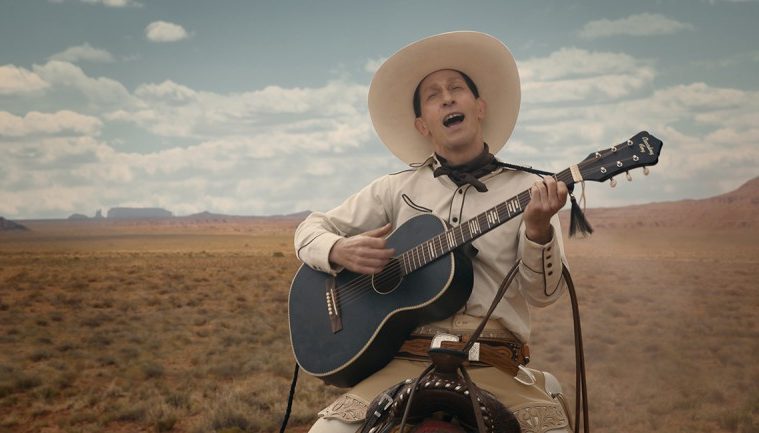
Tim Blake Nelson has worked with Steven Spielberg, Terrence Malick, Ang Lee, and more, but his two most recognizable roles were written and directed by the Coen brothers. Nelson played Delmar O’Donnell in Odyssesian musical O Brother, Where Art Thou? and eighteen years later he plays Buster Scruggs, the singing cowboy in the Coen’s new anthology film The Ballad of Buster Scruggs.
We interviewed Nelson at the 2018 New York Film Festival about Gene Autry’s influence on his character, how the Coen’s thread together six disparate stories of mortality, and Buster’s unique way of shooting fellow character actor Clancy Brown in the film.
The Film Stage: Is Buster, the character, inspired by those old, pulpy, Western dime store stories?
Tim Blake Nelson: I suppose in part, it’s inflective with that, with the “pulpy-dime store-Western” in terms of the provocation and violence and the responding violence and rough justice. But he’s more of a singing cowboy. And the “pulpy-dimestore-rough justice” element comes in as an inflection that’s a surprise, and ends up being part of the wonderful mashup that they wrote.
I think it has to hang its hat on that. I really embraced the notion of “singing cowboy” so when they bring the other surprises in, the violence and the pistol twirling; but mainly the violence, so that when the violence comes in, it’s all the more surprising, because the film has really sold itself as something that’s the opposite of that.
Were you watching Gene Autry movies to prepare?
Yeah, I’ve seen all of them.
Anthology movies often have one director per story, but this is unique because it’s six different stories by the same two directors. Do you think that makes Buster Scruggs different from other anthology films?
Because Joel and Ethan directed each of them, by the time it all ends and you’ve seen the last one, they tie together to me in a very coherent way. It even supplies a take on life that’s probably more important than the film’s storytelling. Because you have this reaper character at the end saying, “We like stories because they distract us from our mortality” and each story in the film does involve, to a degree, mortality. So to me, “The Mortal Remains” story ties them all together in a way they wouldn’t have if each were written and directed by a different filmmaker. Another anthology film that’s made by the same filmmaker is Wild Tales, the Argentinian movie by Damian Szifron.
Were you involved in any capacity with the other stories? I know you weren’t in them, but were you on set?
I was on set a little bit during James Franco’s. Just because we overlap and he and I are close friends. But no, I wasn’t around for the other ones. I think I had dinner with “The Mortal Remains” cast one night when they were down there rehearsing. So I overlapped a little bit. With reshoots, I was with Liam Neeson for a day because we are both reshooting stuff on the same day and doing some additional photography. I read them all.
I was going to ask, did you receive the entire script?
I did and that was very helpful for me because it underscored that I was really going to responsible for making sure I was right there inside the genre of the one I was in. Each one is so distinctive; it reminded me that you gotta, in terms of the acting style, fit with what they’re after in your segment.
How did the Coens film the scene where you shoot Clancy Brown’s character by kicking the table?
Well, in pieces, first of all. That side shot is all practical. There’s no digital. Except for the gunfire, there’s no digital effects. So I’m literally standing there, perfectly still, and doing that. [Nelson mimes the tabling stomping scene from the film]. So it was real.
It’s such a shock. There’s such a twisted delight in what happens.
Moving a little bit away from the character of Buster, the environment and the vistas in the film come off as important, if not more important, than the characters, and I think that’s the most apparent in Tom Waits’ segment. Their nature has a life of its own and he comes to run them out and it returns when he leaves.
The Western genre, because it is definitely caught up in Western expansion, is effectively our version of the romantic landscape, and that’s always going to involve man’s place in nature. How man is either destroyed by nature or taints nature. I think that Joel and Ethan, in embracing the Western genre and dealing with that, and since they’re such breathtakingly visual filmmakers, it’s one of the outstanding features of this movie.
Narrowing in on it, do you think there’s anything in Buster’s story about man and nature?
They do have that classic shot of the guy on his horse, tiny, and in a vast landscape. And that’s always going to end up being a philosophical statement. It’s just like a 19th-century romantic landscape painting.
Do you think Buster is misanthrope?
No, as he says, he doesn’t hate his fellow man, even when they cheat at cards. [Laughs.] But Joel and Ethan wrote a character who only kills in response to a mortal threat to his own life.
So you don’t think his upright appearance and moralism masks anything?
I don’t. He is who he is. As an actor you advocate for your character. And so of course I love Buster, and that was the only way to play a character like that. They did write a guy who doesn’t ever just walk in and kill somebody. Somebody is always pulling a gun on him. He never initiates gunplay.
The Ballad of Buster Scruggs is now in select theaters and hits Netflix on November 16.

